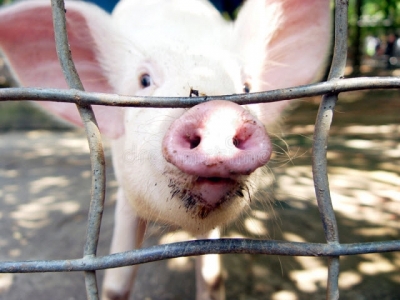Disadvantages of all-in, all-out systems on pig farms

The benefits of all-in, all-out systems have been well-documented in terms of health and biosecurity. However, there are downsides in terms of practical and economic management.
Jack Schiffer I Dreamstime | To avoid nose-to-nose contact, paddocks need have a double line of electric fencing.
The potential negative effect on profitability of introducing disease onto pig farms means that all-in, all-out systems have grown in popularity. This is particularly the case following outbreaks of porcine epidemic diarrhea (PED) virus, African swine fever and other highly infectious diseases, which continue to blight the industry.
However, the disadvantages of such systems need to be considered -- all-in, all-out may not suit everyone. To borrow a poultry analogy, "having all your eggs in one basket" in terms of large batches of pigs may not make economic sense for all producers. Similarly, the practicalities of all pigs going through the cycle together, on smaller farms, is not necessarily viable.
All-in, all-out explained
All-in, all-out systems keep pigs together in groups as they move through the phases of production. The groups are closely matched by age, weight, production stage and condition. Animals from different groups are not mixed during their stay on the farm. Each group is moved into a phase of production together, such as from farrowing house into an empty nursery. When a group moves forward, the facility is completely emptied and cleaned ready for the next group.
By comparison, in a continuous-flow system, sows are bred and farrow continuously. The pigs move through the system as individuals, not closely matched age groups. Housing is never totally emptied because pigs or sows are always moving through it.
Practicalities
Whether an all-in, all-out system involves the whole of the facility or by house will depend on the size of the farm. For very large producers these systems can make sense, as they have pigs at different ages, although kept entirely separate, perhaps even on different sites. This means that staff time and responsibilities can be divided according to life stage. However, for a small farm it can mean that the labor intensive farrowing stage, for example, happens all at once.
Managing all-in, all-out systems on outdoor pig units can also be a challenge. In order to keep groups separate they may need to employ double lines of electric fencing around paddocks or other physical barriers to avoid nose-to-nose contact. Although the areas will be rested between groups, there may not be enough acreage to ensure that this period is long enough to reduce infection pressure.
Economics
The requirement for housing may also increase for all-in, all-out systems. The size of the barns needs to match that of the groups, meaning building and investment. Also because facilities must be emptied between groups, producers may feel that space is not used as efficiently as possible. Instead of building separate barns for the production phases, producers may look at partitioning. However, it is not just the floor area that needs to be divided. If airflow between areas or over manure pits is shared, then there will still be spread of pathogens.
In the case of a one-batch all-in, all-out system, cash flow can be a problem; in continuous production, pigs will be regularly sent for slaughter. If there is a disease outbreak, it is often the young animals that are most at risk. On a small unit, if the pigs are in the nursery, then mortality could be very high and the revenue they would have generated is lost, until the sows can be bred again. Where as if age was more varied, more may survive to produce an income stream throughout the year.
Performance
In all-in, all-out systems the animals all move together between phases. If uniformity is good, this shouldn’t be a problem. However, for "tail-enders" there is no opportunity to hold them back on a higher plane of nutrition for a week or two, before the move to grow/finish. Once moved to the next accommodation they may struggle to compete for the food they need to catch up. Conversely, "good-doers" may be consuming the more expensive weaner ration for longer than they require.
Health
Conventional wisdom would say that all-in, all-out systems break the chain of infection and prevent disease buildup. But what about preparing young animals for future disease challenges buy exposing them to pathogens present on farm? Obviously they receive this in part already from the sows, but in the case of less serious conditions, there may be a benefit of having low risk bacteria circulating between the pigs and the environment.
Conclusions
All-in, all-out systems for pig production have many advantages in terms of reduced disease transmission, improved management and performance. However, there are disadvantages, particularly for small producers. Accurate planning becomes essential in this type of system, and there is little room for movement if the economic situation changes. All-in, all-out systems are inherently designed for the average pig; small pigs may have to be sold at a discount, and bigger animals may be wasting money.
Related news
 Piglets need water as much as they need feed
Piglets need water as much as they need feed Providing water to suckling and weaned piglets does not stop at having one water outlet per pen as these animals undergo significant digestive development
 Comparing pig drinking systems
Comparing pig drinking systems Learn more about how pigs' water intake plays a key role in their health and performance
 What you should know about gastric ulcers in pigs
What you should know about gastric ulcers in pigs A common problem in growing pigs, producers can make nutritional and management changes to reduce the incidence of gastric ulcers.